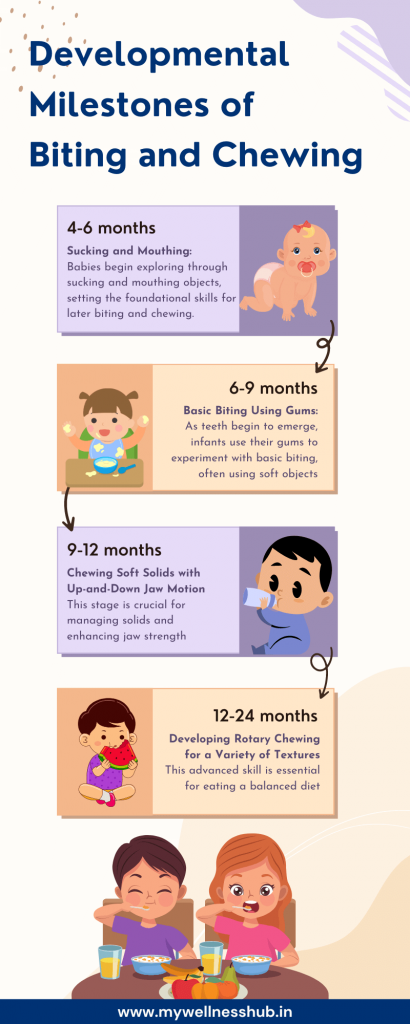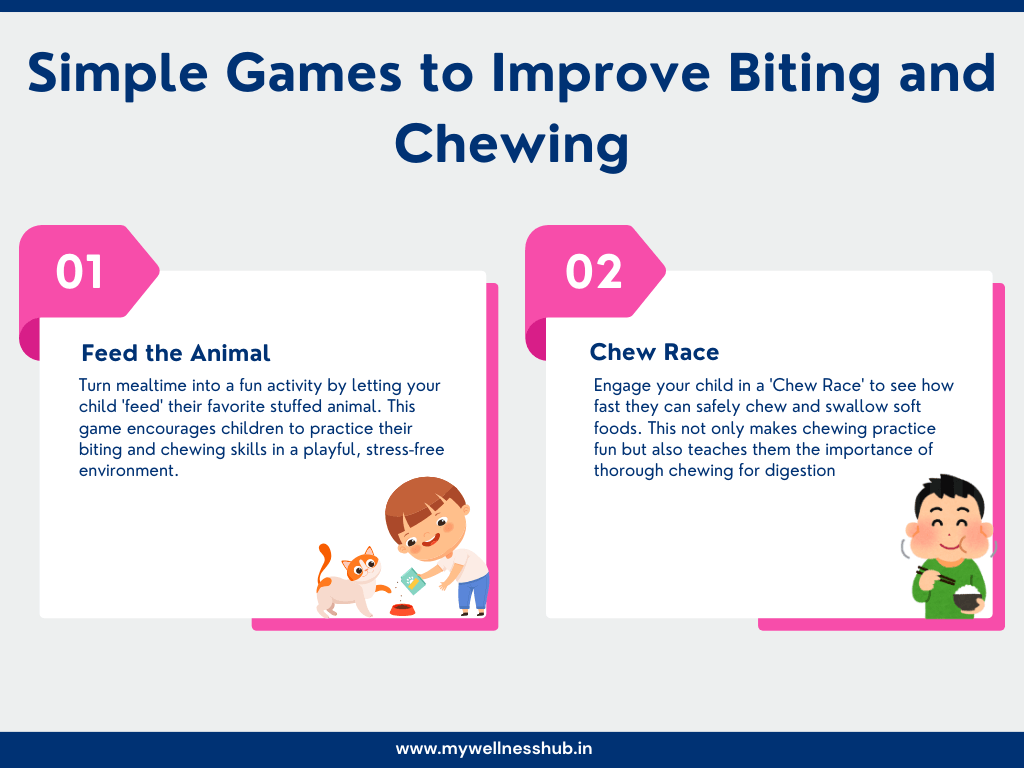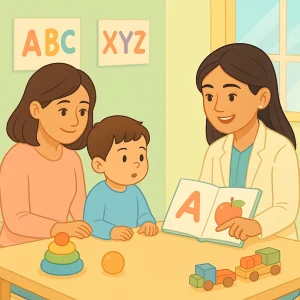Best Biting & Chewing Activities to Improve Kids’ Eating Skills
Last Updated: August 29, 2024
From the moment a child is born, each milestone in their development brings a new wave of excitement and challenges for parents. Among these, the ability to bite and chew is not just about feeding—it’s a vital part of a child’s growth that impacts everything from nutrition to speech development. Understanding the significance of these skills can help ensure your child thrives in these formative years.
As children grow, most will naturally learn how to bite and chew through normal development. However, for some, this isn’t as straightforward. Issues can arise that might require a little extra attention. Maybe your child is a bit hesitant to try different textures, or perhaps they struggle with the coordination needed for effective chewing. Such challenges are not uncommon, but they are manageable with the right strategies and interventions.
Also read: Speech and Language Milestones Guide: Birth to 7 Years
Understanding Biting and Chewing Development
Navigating the Milestones from Infancy
Biting and chewing are more than just eating actions; they are pivotal in a child’s development, influencing everything from speech to how they experience food. Typically, these skills begin to develop around 4 to 6 months of age when infants start exploring the world through taste and touch. This exploration often starts with simple actions such as sucking and progresses to more complex motions involving their lips, tongue, and jaws.
As infants grow, these actions evolve into more deliberate biting and chewing, usually evident when they start consuming solid foods around 6 to 9 months. By their first birthday, most children are able to bite off pieces of soft foods and chew them with a rudimentary up-and-down motion. However, the development of a mature, rotary chewing pattern—which is crucial for handling a variety of textures—might not fully develop until they are around 3 years old.

When to Step In
Despite these general timelines, each child’s developmental path can vary. Some might need a little extra help, and that’s perfectly okay. Signs that intervention might be necessary include:
- Difficulty managing solids by 12 months.
- Excessive drooling or food spillage during meals.
- Avoidance of certain food textures.
- Persistent use of front teeth to bite rather than using a whole-mouth action.
Recognizing these signs early can help parents and caregivers provide the targeted support their child needs to thrive in their eating adventures.
Also read: Early Identification/ Warning Signs in child development
Essential Tools to Aid Development
Introducing Tools that Make a Difference
To assist children who need a bit of extra help, various oral motor tools have been designed to enhance their biting and chewing skills. Tools like the Grabber, Y-Chew, and Z-Vibe are not only effective but also fun to use, making them a hit among little ones.
- The Grabber: This is a perfect starter tool for young children. It’s designed to promote chewing and biting through engaging sensory experiences. Its texture and resilience encourage children to explore different jaw movements and pressures, which is essential in building muscle tone and control.
- The Y-Chew: This tool extends the benefits of the Grabber by introducing more varied textures and resistance levels. It helps in refining jaw movements further and can be used to simulate different food textures, preparing children for a wider range of eating experiences.
- The Z-Vibe: Perhaps the most versatile of the trio, the Z-Vibe uses gentle vibrations to wake up the mouth’s sensory receptors. This is particularly beneficial for children who are less sensitive to oral stimuli or who tend to be more tentative with foods. The vibration also encourages natural biting and chewing reflexes, which are crucial for developing proper oral motor skills.
Read more: What are the therapies offered to Autistic patients? | Therapies of Autism
Activities to Improve Biting and Chewing

Transforming Challenges into Fun Learning Experiences
Biting and chewing are not just necessary skills for eating; they are opportunities for learning and development. With the right activities, you can turn these essential skills into enjoyable and enriching experiences for your child. Here are three engaging activities designed to improve your child’s biting and chewing abilities.
Activity 1: Hands-On Learning with Oral Motor Chew Tools
Start by introducing specialized chew tools that are both safe and effective for young learners. Tools like the Grabber, Y-Chew, and Z-Vibe are excellent for hands-on practice.
- How to Use: Let your child explore these tools under supervision. Encourage them to feel the textures with their lips and tongue, and demonstrate how to bite down gently. These tools are designed to be interesting to the senses, which helps keep the child engaged.
- Goal: The aim is to strengthen the muscles involved in biting and chewing while also enhancing oral tactile sensitivity. This foundational activity paves the way for more complex eating skills.
Activity 2: Demonstrating Biting and Chewing Techniques
Using a combination of chew tools and real food can help translate what children learn from tools to actual eating scenarios.
- How to Demonstrate: Start by showing how to bite using soft foods that are easy to break down, like banana or cooked carrot. Use the chew tools to demonstrate the motion and then mimic this with food.
- Engage Your Child: Allow your child to practice with the food after demonstrating. Offer praise and gentle guidance to reinforce positive efforts and correct techniques.
Detailed Foods for Practicing Biting and Chewing Skills
| Food Type | Texture Description | Age Appropriate | Developmental Benefits |
|---|---|---|---|
| Soft-cooked fruits | Fruits like banana, avocado, and apple are cooked until very soft or mashed/pureed. Easy to gum down and swallow, minimal chewing required. | 6-9 months | Introduces the concept of solid foods and helps develop initial biting skills with minimal effort. |
| Cooked vegetables | Vegetables such as carrots, peas, and squash are cooked until soft enough to be squished easily between fingers. Cut into small pieces for safety. | 9-12 months | Encourages the use of the jaw and molars for mashing, improving muscle strength and coordination in the mouth. |
| Meats | Tender meats like chicken or turkey are cooked until soft and then shredded or cut into tiny pieces that are easy to chew. | 12-24 months | Promotes the development of more complex chewing skills and introduces textures that require coordinated chewing movements. |
Know more about on 12 Activities to Boost Kids Speech & Language
Progressive Techniques for Advanced Chewing Skills
Building on the Basics: Enhancing Chewing Abilities
Once your child is comfortable with the basic biting and chewing exercises, it’s time to introduce more complex skills that involve a wider range of food textures. This progression is crucial not just for their oral motor development but also for ensuring they can safely and effectively handle different types of foods as they grow.
Advancing Chewing Techniques
- Start with Mixed Textures: Begin by mixing soft foods with slightly more challenging textures. For example, add small pieces of soft-cooked vegetables to mashed potatoes. This introduces a new element without overwhelming your child.
- Graduate to More Complex Foods: As their confidence grows, increase the complexity of the foods. Introduce well-cooked pasta, rice, and tender meats cut into small, manageable pieces. These require more sophisticated chewing movements and help strengthen the jaw muscles.
- Encourage Whole Mouth Use: Initially, children may use only the front teeth to bite. Encourage them to use the sides of their mouth. This can be facilitated by placing foods like small cubes of cheese or soft fruits directly on the molars with a safe utensil.
Tips for Integrating Real Foods and Textures
- Safety First: Always ensure the pieces are appropriately sized to prevent choking. As a rule of thumb, pieces should be no larger than a small pea for young toddlers.
- Keep It Fun and Engaging: Use playful descriptions for the food textures, like calling lumpy mashed potatoes “clouds with bumps” to make the experience fun and less daunting.
- Use Visual and Verbal Cues: Demonstrate chewing with your own mouth open to show how the molars move in a rotary motion. Verbal cues such as “chew like a cow” can make the activity humorous and memorable.
Encouraging Self-Feeding with Diverse Textures
As your child becomes more adept at handling various textures, encourage self-feeding. This not only improves their fine motor skills but also enhances their independence and confidence at mealtime.
- Introduce Utensils: Start with thick-handled spoons or forks and guide your child’s hand if necessary. This helps them feel more in control and integrates sensory feedback from handling the utensils.
- Vary the Foods Regularly: Regularly changing the types of foods offered can prevent boredom and encourage a willingness to try new textures. It’s also an excellent way to ensure a balanced diet.
Conclusion
We’ve learned a lot about helping kids develop biting and chewing skills. From using special tools like the Grabber and Y-Chew to fun eating games, these techniques make learning easy and fun. Remember, each child grows at their own pace, so keep encouraging them with patience and consistency.
If you ever need more tips or want to learn about other ways to help your child grow, check out our website, Wellness Hub. We’re here to support you and your child every step of the way. Thanks for letting us be part of your journey to healthy and happy mealtimes!
Frequently Asked Questions:
1. What are the best tools to help children develop biting and chewing skills?
Tools like the Grabber, Y-Chew, and Z-Vibe are excellent for helping children enhance their biting and chewing abilities. These tools are designed to be fun and engaging while effectively strengthening the oral motor skills necessary for chewing and biting different textures.
2. At what age should children start developing biting and chewing skills?
Children typically begin to develop biting and chewing skills around 4 to 6 months old as they start exploring foods of different textures. By their first birthday, most children are ready to handle soft solid foods.
3. How can I make learning to chew and bite fun for my child?
Incorporating games and playful activities into mealtime can make learning to chew and bite more enjoyable for children. For example, feeding games using puppets or pretending that the spoon is an airplane can engage your child’s imagination while encouraging them to try new movements and textures.
4. What are some signs that my child might need extra help with biting and chewing?
Signs that your child might need additional support include difficulties in managing solid foods by 12 months, excessive drooling, avoiding certain food textures, and using only the front teeth to bite. If you notice any of these signs, consider introducing specialized tools and exercises to aid development.
5. How can I safely introduce new food textures to my child?
Start with soft, easily mashable foods and gradually introduce more complex textures. Ensure all pieces are small enough to prevent choking and encourage your child to use their entire mouth for chewing. It’s important to monitor their reaction to different textures and adjust the food sizes and types accordingly.
6. Where can I find more resources on developing my child’s biting and chewing skills?
You can find a variety of resources, expert advice, and practical tips at Wellness Hub. Our dedicated section on child development offers comprehensive support and information to help your child master essential eating skills.
7. How long does it take for a child to develop mature chewing skills?
The development of mature chewing skills varies among children, but most children can chew a variety of textures by the age of 3. The progression from basic up-and-down munching to more complex rotary chewing typically evolves as they are exposed to different food textures.
8. Can teething impact my child’s ability to learn biting and chewing?
Yes, teething can impact a child’s ability to learn biting and chewing as it can cause discomfort and make them reluctant to bite or chew. Offering teething toys that also serve as food feeders can help ease this transition and soothe their gums while introducing them to new textures.
9. What foods are good for practicing biting and chewing for toddlers?
Great foods to practice biting and chewing include soft-cooked fruits and vegetables, like carrots and apples, small pieces of soft meats like chicken, and dissolvable foods such as oat cereal or puffs. These foods encourage practicing various chewing techniques while ensuring safety.
10. How can I support my child if they show a reluctance to chew?
If your child is reluctant to chew, start with their preferred textures and gradually introduce new textures mixed with the old ones. Make mealtime relaxing and pressure-free. Using stories or characters during meals to model chewing can also help make the process more engaging and less intimidating for your child.
About the Author:
Anuradha Karanam
Speech-language pathologist (7+ years of experience)
Anuradha Karanam is a skilled speech-language pathologist with over 6 years of experience. Fluent in Tamil, Telugu, Hindi, and English, she specializes in parent counseling, speech sound disorders, fluency assessment, and speech-language evaluations. Anuradha excels at working with children with developmental disorders, offering creative and effective therapy programs. Currently at Wellness Hub, she holds a BASLP degree and is registered with the RCI (CRR No A85500). Her patience, ambition, and dedication make her a trusted expert in her field.
Book your Free Consultation Today
Parent/Caregiver Info:
Client’s Details:
* Error Message









